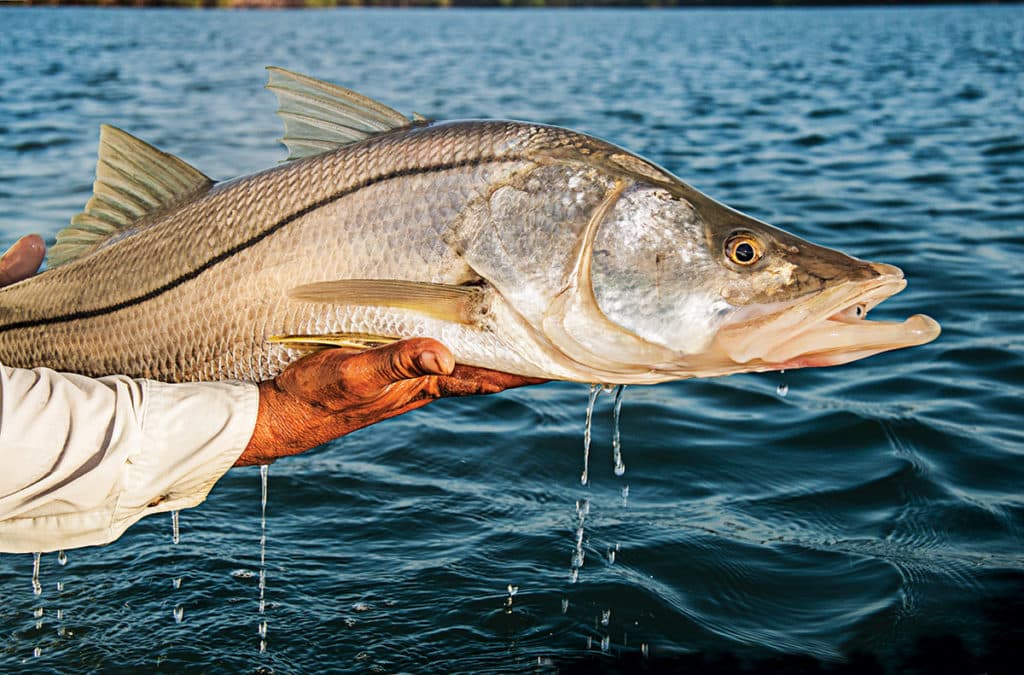
Merely mentioning the prospect of catching a slob snook grabs the attention of even the most experienced angler. Ever since the day I caught my first Florida linesider, a modest 5-pounder at Clam Pass, a few miles north of Naples, this iconic species has had me hooked.
In the 20 years since, plenty more Florida snook have found my hooks, but never one larger than 20 pounds. And while I’ve tackled bigger specimens in Central America, I’ve always had a hankering to catch and release a trophy from the Sunshine State. That goal is fast becoming an obsession, and I find myself focusing fishing efforts on my long-held dream. Along the way I’ve spoken with numerous pros, formulating a better blueprint to target Florida’s trophy snook.
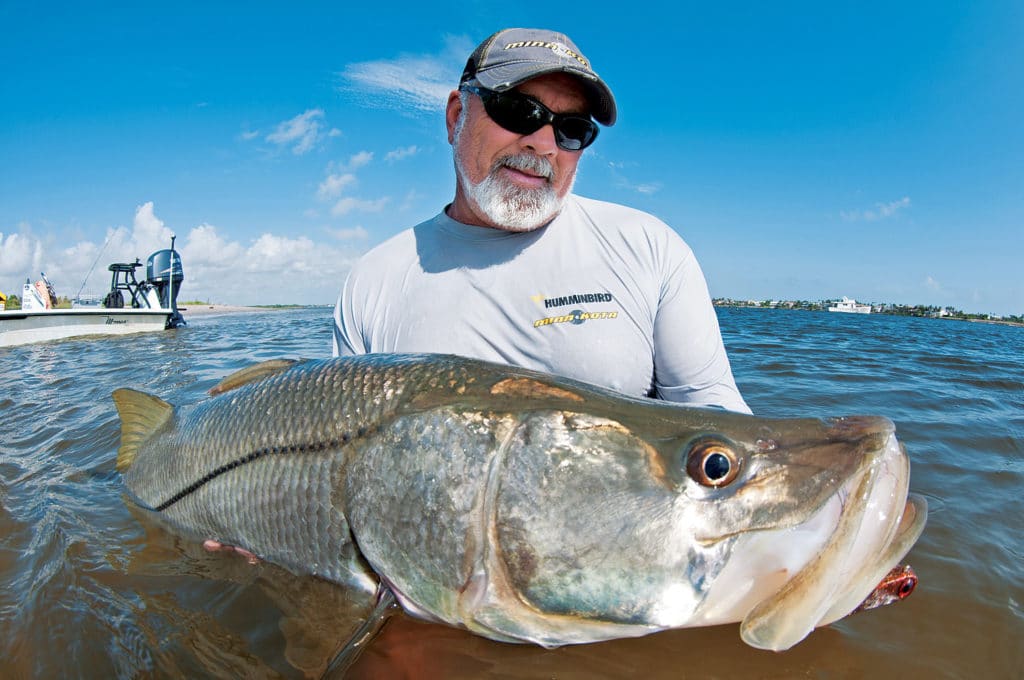
Gulf Coast Galore
Sarasota-based guide Capt. Dave Pomerleau, sometimes called the “Mad Snooker,” lives and breathes big snook. That’s hardly surprising, as Pomerleau claims the unofficial state record for his 44-pound, 11-ounce fish, caught in 1995. Unfortunately, his worthy catch was not weighed on an International Game Fish Association-approved scale, which negated its accreditation for record status.
When asked about the best place to catch a 20-plus-pounder, Pomerleau doesn’t hesitate. “Inlets and passes, especially John’s Pass, Clearwater Pass and Boca Grande — anywhere there is a good, fast flow of water,” he says. “May and June are the best months here on the Gulf Coast, and fishing at night is most productive for very big fish — just not during the peak of a full moon.”
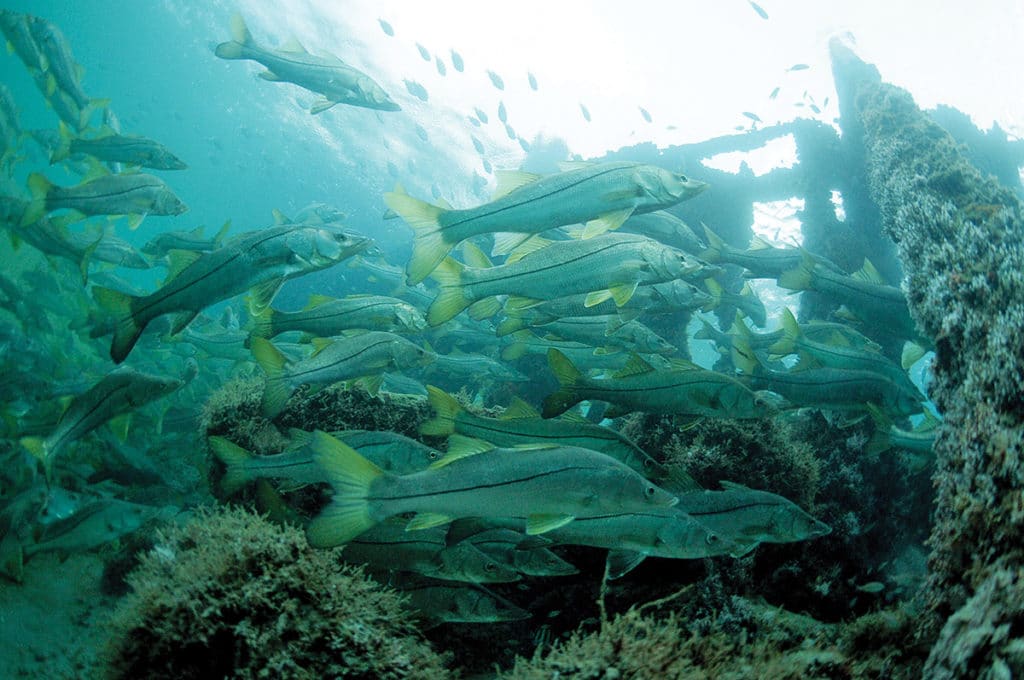
Both bait and lures work well for trophy snook; Pomerleau uses both on a roughly 50-50 basis. “If specifically targeting overslot snook, I use big baits like a 10- to 14-inch live mullet,” he says. “My lure of choice is a 9-inch SpoolTek Stretch swimbait, a realistic jig-head, rubber-tail combo that features a hidden leader.”
Patience and stealth are important. You’ve got to be stealthy when fishing for overslot fish. No stomping loudly aboard a boat, no flashy lights. Try to locate fresh fish that haven’t been cast to earlier in the day and developed lockjaw.
“It’s like bird hunting,” Pomerleau explains. “You don’t want to walk up on birds in a field that have been shot over earlier in the day and are skittish as hell; big snook are just the same.”
Snook hang around sea walls, docks, jetties and bridges, venues that can often be accessed on foot as well as by boat. Sneak into position, cast up-current of fish to avoid spooking them, and allow the tide to carry your lure down to the fish. Snook hang in eddies near structure, almost like largemouth bass, waiting for baitfish to flow by with the current.
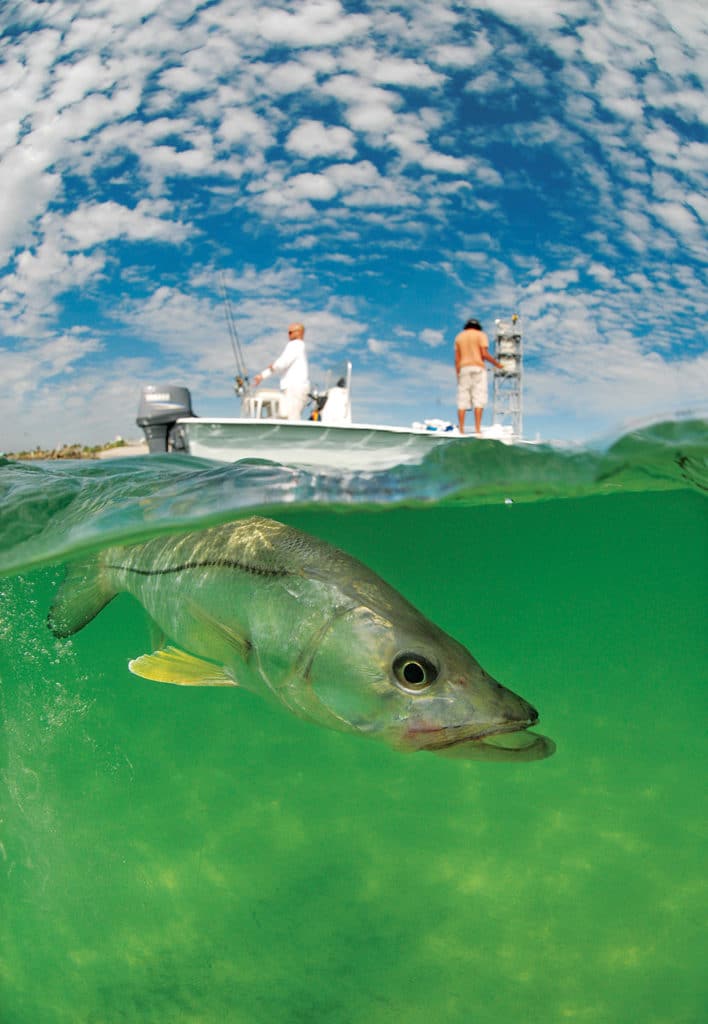
Down South
Ron Taylor, a fisheries research biologist at the Florida Fish and Wildlife Conservation Commission’s Fish and Wildlife Research Institute, studies Florida snook for a living. In 2014, he was the recipient of the prestigious American Fisheries Society William E. Ricker Resource Conservation Award, and is widely regarded as a world expert on snook.
His thoughts on catching trophy snook are invaluable for anglers targeting linesiders. “The best place to catch big snook depends on the season,” he says. “During spring and summer, your best bet is to fish structure found at inlets. During late fall and winter, better fishing is available in coastal rivers with shoreline trees, limbs, piers and other structure.”
Fish the last hour of an incoming tide and the first three hours of the falling tide for optimal water movement. Snook aggregations occur on the new moon, though the fish form spawning groups at inlets and passes each day in April and May, says Taylor, and then again from September through October.
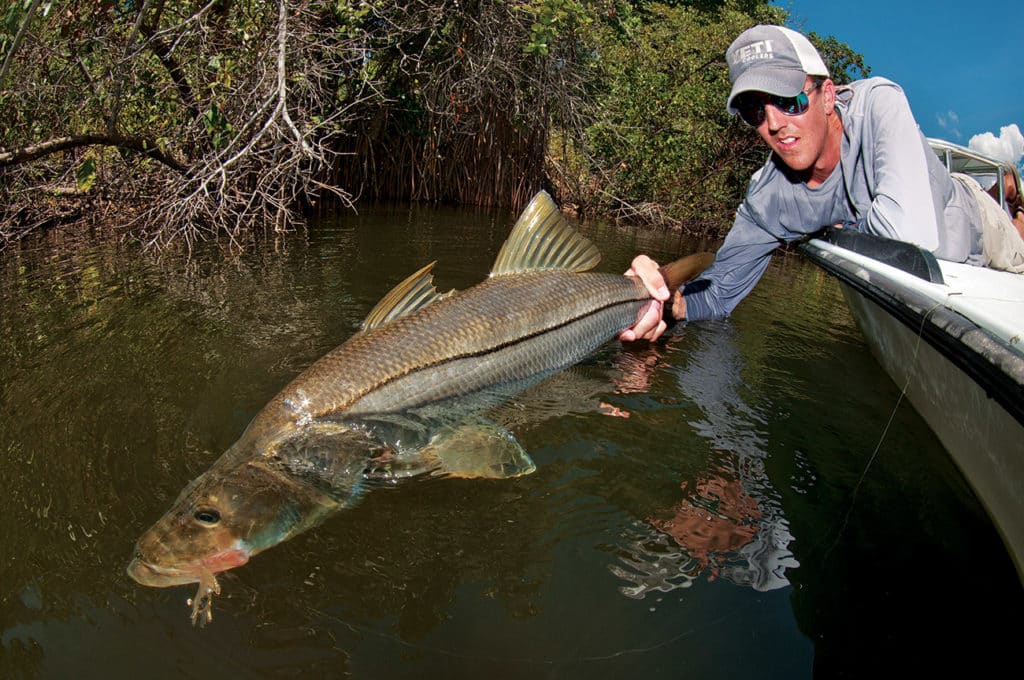
When fishing with lures at night, use chartreuse plugs such as the Bomber Long A or red-and-white lead-head jigs. During daylight hours, go with plugs such as Rapalas or MirrOlures, or artificial shrimp and crabs.
“With live bait, fish the inlets during the early morning, before sunup, using croakers or scaled sardines,” Taylor says. “Anchor your boat up-current and fish back to the structure.”
Legendary Miami-based sport-fishing captain Bouncer Smith needs little introduction. He does most of his snook fishing at Government Cut, with his best snook a 34-pounder.
“The biggest snook are found at inlets and spillways between Boynton Beach and Fort Pierce,” Smith says. “If I were targeting large snook in my area, I would fish the spillway at Greynolds Park, in North Miami Beach.”
Soaking large live baits on the bottom in the morning during May or June, especially after heavy rain, is a top technique. When those floodgates first open, big snook gather for the forage that pours out with the water. Big bucktails with rubber tails and soft-plastic baitfish imitations are prime artificials to use.
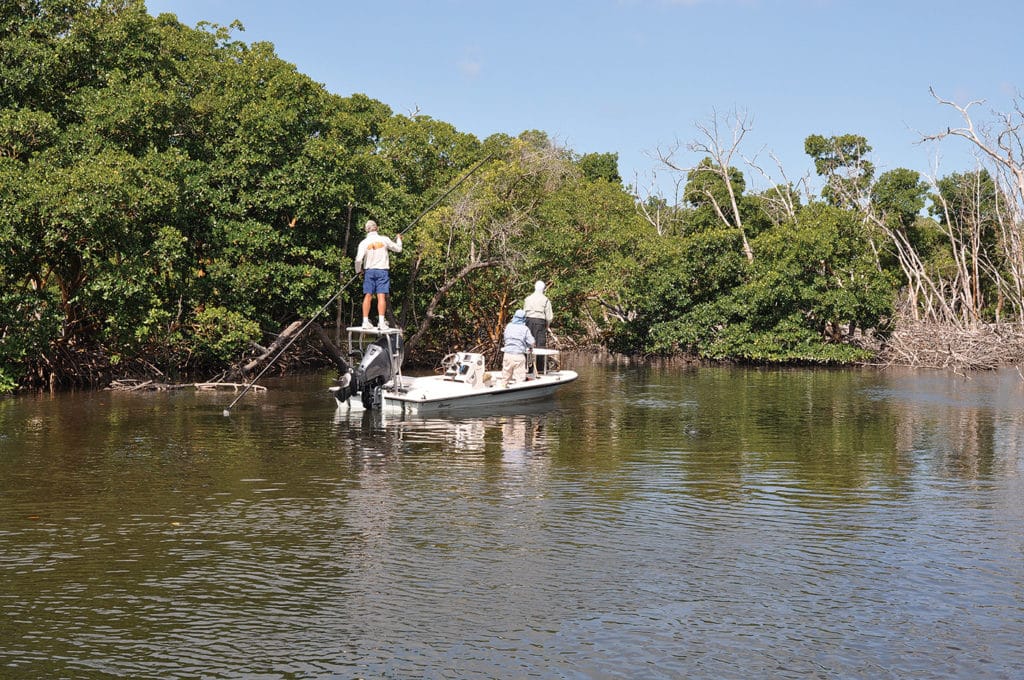
10,000 Snook Lairs
In southwest Florida, starting at Cape Romano, near Marco Island, and extending south to Lostman’s River, it’s not hard to believe the Ten Thousand Islands were purpose-built for snook. The countless islands offer plenty of habitat in an undeveloped wilderness dissected by interconnecting channels and secluded bays. Local waters are lined with limitless mangroves, a perfect nursery for myriad species, including juvenile and trophy snook.
Connected to Everglades City via a single causeway, Chokoloskee (population about 400) is regarded by many as a snook epicenter. Snook outnumber people in this last community before entering Everglades National Park. The current Florida fly-caught record of 30 pounds, 4 ounces was landed here. Kenny Brown, who manages Outdoor Resorts of Chokoloskee Island, a marina, recreational-vehicle resort and tackle shop, has a beat on the pulse of the local snook fishery.
“Snook fishing in the Ten Thousand Islands kicks off around mid-April and remains excellent right through the summer months until mid-November,” Brown says. “Chokoloskee is prime for 20-pound trophy fish from May through September, with the area between the Lostman’s and Shark rivers especially productive.”
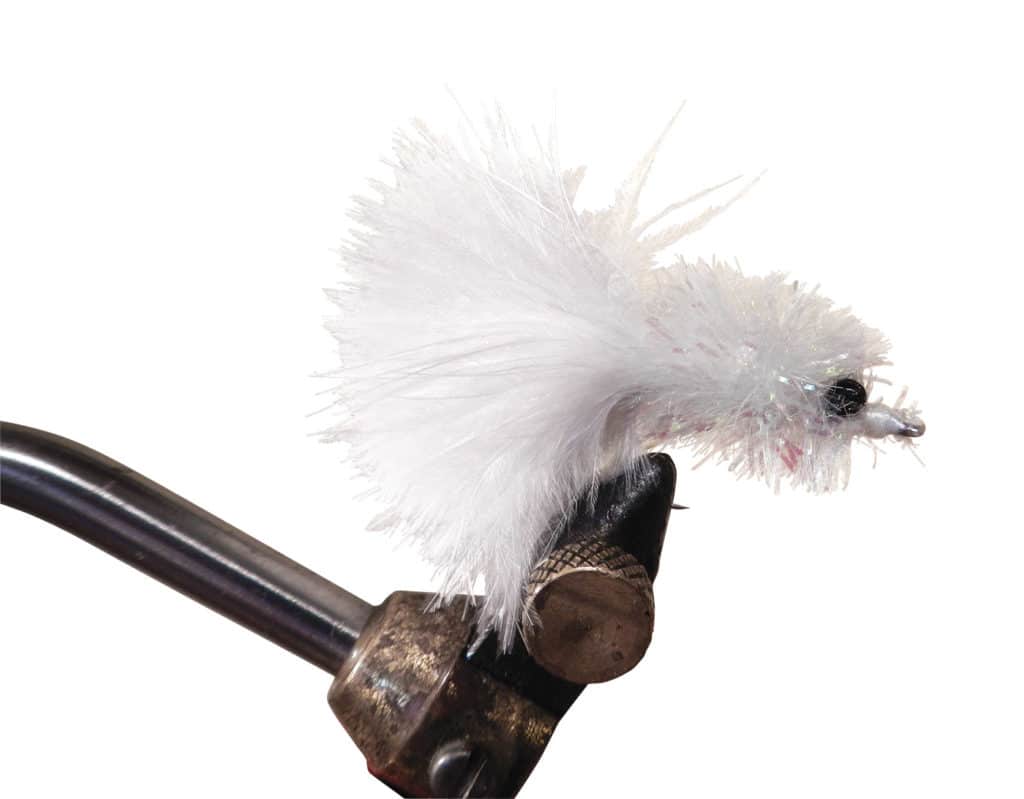
Summertime at the Beach
During summer, when their metabolism is at its highest, snook attack lures such as chartreuse plugs and topwater baits. For fall and winter, smaller lures work best at slower speeds. If you would rather utilize a natural offering, a lively 4- to 5-inch greenie (threadfin herring) or jumbo shrimp is tops.
Farther north along the Gulf Coast, the entire Fort Myers area, including the Caloosahatchee River, Pine Island Sound, and the twin barrier islands of Sanibel and Captiva, is another great area for trophies. The current state-record fish was caught here, weighing 44 pounds, 3 ounces.
Some of the very best fishing involves sight-casting to snook cruising and laid up along the white sand beaches. Fly-fishing is especially popular here. Norm Zeigler, who runs his own fly shop on Periwinkle Way, on Sanibel Island, is a local authority on fly-fishing. Zeigler’s book Snook on a Fly is widely regarded as the definitive work on the subject.
“There are lots of trophy fish available along the beaches during the summer months,” Zeigler says. “Fly-fishing is a very productive technique; I’d say it can out-fish other techniques by as much as 8-to-1.” Small white flies such as Clousers, Deceivers or the Crystal Schminnow work best from June to September, but fly-anglers must hit the sand early, casting at first light, before sunbathers take over the beaches.
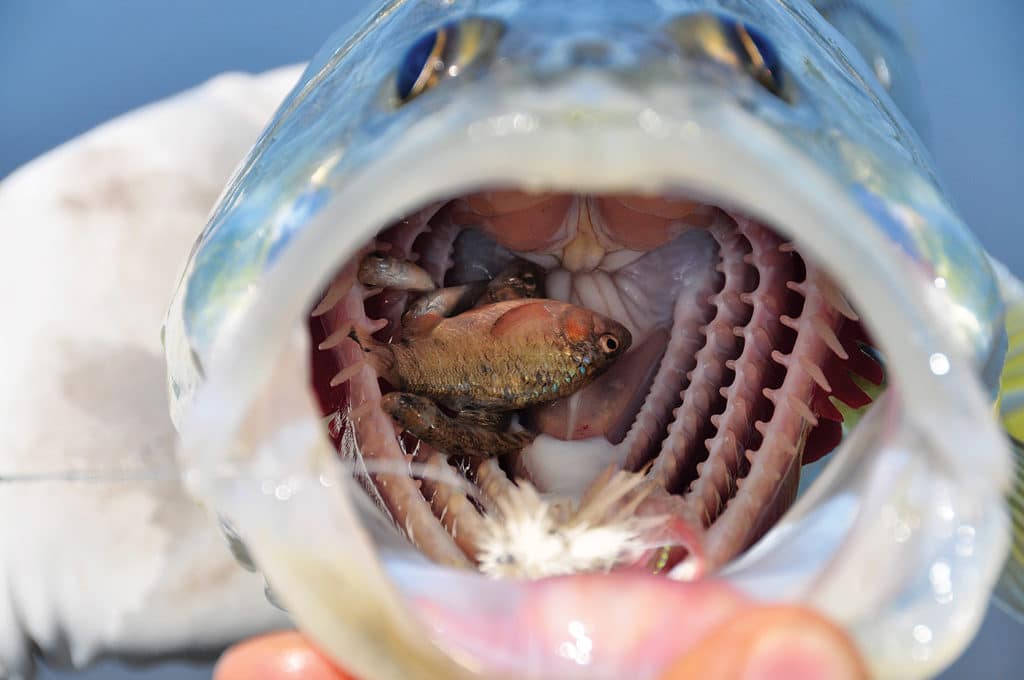
Limit the Live Bait
Across the state, on the Atlantic, kayaker Jerry McBride specialized for many years in targeting snook around Jensen Beach and Stuart, about 45 miles north of Palm Beach. McBride mostly kayak-fishes in the Florida Panhandle these days, but he points out that east coast snook are consistently larger than those on the west coast. When asked where’s the best place to catch a 20-pound snook, McBride replies: “Easiest or best? It’s easy to catch spawning snook on live bait at inlets, around deep bridges at night, or over nearshore wrecks. I find it much more challenging and entertaining to catch them on knee-deep grass flats with light tackle.” The optimal time for grass-flats fishing is April through September in southeast Florida. McBride prefers the last half of a daytime outgoing tide, ideally around the new moon. No live baits are necessary.
“I wouldn’t get out of the electric chair to fish with live bait,” he jokes. “Snook have a brain smaller than a pea; if you can’t fool them with an artificial lure, take up golf.” McBride prefers suspending plugs, topwaters or weedless soft plastics in natural colors.
Neil Taylor, a kayak angler and guide based in Tampa, agrees that the east coast produces the biggest snook in Florida. “Jupiter Inlet, that’s currently the number one big-snook location in the state,” he says. “There are good opportunities in southwest Florida, but many areas are only finally recovering from the 2010 freeze.” Taylor mostly fishes lures, and is quick to emphasize the importance of fishing with moving water, especially at night. He always uses fluorocarbon leader line, at least 30-pound-test, for a stealthy approach. “Snook are ambush feeders; avoid the ‘suicide bait’ situation,” he says. “What baitfish is going to swim right up to a large predator without spooking it?”
He gives sound advice for handling trophy snook: “Do not hang these fish vertically at any time. Get quick photos with the fish supported properly and horizontally, using two hands; this maximizes the chance the fish will survive the encounter. Snook are pretty tough fish, but minimize the stress so they can dominate Florida again.”
The key to Florida-snook success is obtaining the right information from the best sources. There are none better than what’s provided here. The next time I target a Florida trophy, it’ll be during the summer months in low-light conditions. I’ll fish stealthily and away from other anglers, ideally around a new moon. And I’ll be concentrating on structure near passes, inlets and bridges with strong water flow. That 20-pounder doesn’t stand a chance.
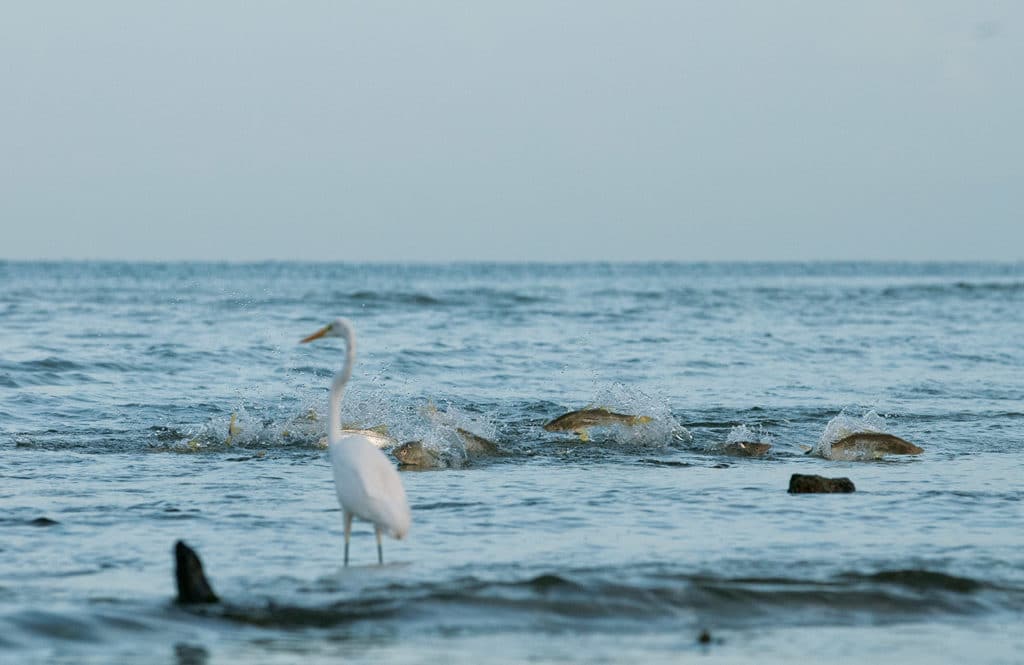
A Proper Introduction
Numbers: Of the five snook species in Florida, the common snook (Centropomus undecimalis) grows the largest and is most sought after, ranging throughout the western Atlantic from Brazil to the Caribbean to the southern United States. Florida and southern Texas anglers have the best opportunity to land a giant in the States. Biology: Snook are sequentially hermaphroditic, changing from male to female after maturation to spawn. They are also euryhaline, or able to thrive in both salt and fresh water. As ambush predators more so than active hunters, they prowl brackish estuaries with specific topographies, such as mangroves, grass flats, oysters and even bridge pilings.
One factor limiting the species geographically: They can’t tolerate cold water, not even for a couple of days. Snook become lethargic when water temperatures fall to 65 degrees F and begin to die once temperatures hit 60. Florida’s cold snap in January 2010 was a tragic demonstration of this tendency, when an estimated 42 percent of the snook population perished.
Fishy Biz: Snook are a valuable resource to the state of Florida. In 2013, the year of their last stock assessment, anglers in Florida made 3.5 million snook-fishing trips. The estimate for direct expenditures per trip was about $450. That’s close to $1.6 billion in one year. Factor in saltwater licenses and snook permits, and that’s an astounding total. The Sunshine State’s snook fishery is tightly regulated, with exact seasons, bag limits and slot lengths listed on the Florida Fish and Wildlife Conservation Commission website.
Beyond Florida
The IGFA all-tackle record for common snook weighed 53 pounds, 10 ounces and was caught in Costa Rica in October 1978. Florida’s state record is 44 pounds, 3 ounces, landed near Fort Myers, on the Gulf Coast. Big common snook are reliable along the entire Caribbean coast of Central America, with Costa Rica and Nicaragua producing the biggest fish recently. Just as in Florida, fishing in and around the passes and rivers entering the ocean, as well as structure fishing, is often the key. Big fish are caught year-round, with optimal days coinciding with fish moving inshore to spawn at the end of the rainy season, usually from October to December.








